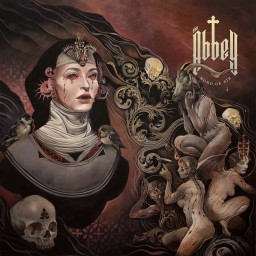 Review by Sonny for Abbey, The - Word of Sin (2023)
Review by Sonny for Abbey, The - Word of Sin (2023)
The Abbey are a Finnish five-piece who play doomy gothic metal with some progressive tendencies. Probably the most well-known member is female vocalist Natalie Koskinen who is, of course, vocalist with funeral doom merchants Shape of Despair. The Abbey employ dual male/female vocals, but shy away from the "beauty and the beast" style of male growls and ethereal female wails, focussing on a harmonised and layered clean delivery. Formed in 2021, Word of Sin is the band's debut full-length release.
At their doomiest a comparison with Draconian Times-era Paradise Lost is justified, but that isn't the only card they play. They throw in a couple of quicker tracks, A Thousand Dead Witches and Temple of Pain, that have galloping, heavy metal-style riffs that energise the album and contrast quite nicely with the slower, more laconic material. In truth, though, for me there isn't enough weight to the majority of the album and it sits quite firmly on the lighter side of the gothic doom fence, concentrating on producing beautiful melodies rather than playing to the melancholy, sorrowful nature that the best of the genre has to offer. Admittedly, what they do, they do very well and Word of Sin has some very nice melodies indeed which may stay with you well after the album has finished playing.
The album ends with the Lovecraftian-themed two-parter of Old Ones Prequel and the almost thirteen minutes of Old Ones itself and sees The Abbey indulge a more progressive side of their sound. Old Ones Prequel is an acoustic guitar and male-voiced piece with singer Jesse Heikkinen sounding very much like Wayne Hussey of UK gothic rockers The Mission and serves as an intro to the album's main event. Old Ones proper begins with an ominous doomy atmosphere that possesses one of the albums most memorable melodies combined with some very nice, soaring lead work. Around mid-point the melody fades and we are treated to an organ-led instrumental passage that evokes a high-ceilinged and expansive volume of space set aside for the worship of the unseen Old Ones, eventually giving way to a ponderous riff, more soaring lead work and a harmonised choral vocal that combine as one to a rather satisfying crescendo. This closing two-parter is by far my highlight of the album and the band's unleashing of this more progressive side is a path I hope they continue down with further releases.
The production on Word of Sin is decent, but again emphasises the lighter over the darker and heavier. The vocals and guitar leads are given particular prominence with the riffs lacking the density that I prefer in any doom-related enterprise and with the rhythm section taking a back seat for the most part. The production, however, does perfectly suit the Old Ones and it's more progressive tendencies and serves to emphasise just how superior this closing section of the album is.
